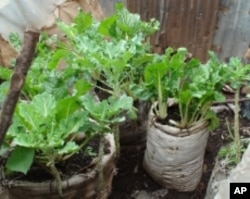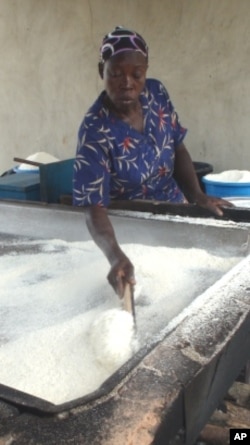Sub-Saharan Africa harbors most of the world’s hungriest countries. But the report from the Worldwatch Institute, a Washington, D.C.-based environmental group, says the continent is also home to a wealth of ideas that can help the rest of the world fight hunger and poverty.
Report co-author Danielle Nierenberg spent a year on a 25-nation tour of innovations in African farming and found them in some surprising places.
In Kibera, the largest urban slum in Nairobi, Kenya, and one of the largest on the continent, she found women farmers growing nutritious vegetables just outside their doorsteps using nothing more complicated than old sacks filled with soil.
It saves money. And what they don't eat, they sell, using the revenue to put their children through school.
They even helped feed Kibera through the turmoil and violence that followed Kenya's 2008 election dispute.
Cities feeding citizens
"It’s a slum," she says. "It’s depressing. It’s crowded. It’s dirty. It’s noisy. But these people are finding ways to make their lives better."
With half the world’s population now living in and around cities, experts are increasingly looking to these kinds of ideas in urban agriculture to feed malnourished city dwellers -- not just in Africa, but around the world.
And with nearly a billion people worldwide going to bed hungry, Nierenberg says that’s the point of the 237-page report: "I think there are a lot of lessons that we in the Western world can learn from Africa. And what they are doing is certainly applicable to other developing countries."
She says the report, entitled, "Innovations that Nourish the Planet," is intended as a roadmap for increasing agricultural investment to alleviate global hunger and poverty.
Saving the harvest
For example, in many developing countries, farmers lose 25 to 40 percent of their harvest to pests, spoilage or inappropriate handling before it can reach the market. That aggravates hunger and pushes up prices.
But in Nigeria, some farmers have cut losses in half with the help of village processing centers, set up to turn cassava into staple foods. As an added bonus, they earn more money from these processed products.
Nierenberg says the world’s hunger fighters should pay more attention to preserving the harvest.
"Given all that we invest in producing food in the first place," she says, "we need to devote the same amount of attention to making sure that it’s not wasted."
Work with what you have
"These innovations really focus on what you can do with what you have, with some additional inputs from the outside, of course," says Daniel Gustafson, head of the Washington, DC office of the U.N. Food and Agriculture Organization. He says that's especially important for poor farmers, who are among the most at risk of hunger.
And Gustafson adds that with programs for developing-world farmers so often driven by outside interests, the focus on African farmers brings up another key point: "How important it is for researchers and donors and governments to pay attention to farmers and what they know and what they’re trying out."
Hopeful
Having grown up seeing images of hunger and conflict dominating news from the continent, Nierenberg says her year-long excursion was much different than she expected.
"I went to Africa with very little hope in my heart, and was so surprised by everything I saw," she says. "So I do see hope in all the innovations we saw on the ground."
However, she says she is less optimistic that farmers will get the support they need. Although several African countries have recently begun devoting significant portions of their national budgets to support agriculture, Nierenberg says greater commitments are needed to make these innovations that nourish the planet succeed.















